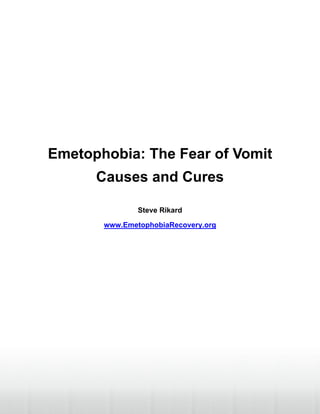
Emetophobia causes and cures
- 1. Emetophobia: The Fear of Vomit Causes and Cures Steve Rikard www.EmetophobiaRecovery.org
- 2. What is Emetophobia? Emetophobia is an extreme and irrational fear of vomiting. Emetophobes experience intense anxiety over thoughts of themselves vomiting, others vomiting in their vicinity, or simply seeing vomit. This is one of the most common phobias in the world, but it is also a phobia which very few people know about. The fear of vomiting often spreads to become a fear of any situation with which vomiting may be associated with. Examples of this include: • Consuming alcohol or being around others who are consuming alcohol • Avoid eating unhealthy foods</li> • Excessive cleanliness</li> • Avoid eating in public or anywhere outside of their own home • Avoid traveling by any means which might cause motion sickness • Being in the vicinity of young toddlers • Avoid anyone who is sick or may be sick, including family members • Avoid infants • Be afraid of pregnancy and the morning sickness that is associated with it • Avoid hospitals or any place where sick people might be • Nightmares In many emetophobes, these behaviors are taken to extremes, such as obsessive checking of food expiration dates, eating only fruits and vegetables, or an inability to take care of their own children. These fears can be extremely debilitating, and greatly harm the emetophobe’s social life Emetophobia has also been associated with a fear of not being in control. This originates from viewing vomiting as something that strips you of control over your own body. Of all things you can lose control of, losing control of your own body might seem the most personal, so vomiting may be avoided at all costs.
- 3. What Causes Emetophobia? Most phobias, including emetophobia, usually develop from childhood experiences that severely traumatized the individual. When a young child experiences a trauma, their brain takes action to prevent that situation from occurring again. In the case of a traumatic incident involving vomit, the brain can imbue the individual with a fear of vomit in order to protect them. The act of vomiting itself may not have been what caused the trauma. Rather, the conditions surrounding the act of vomiting may have been what was traumatic. For example, an individual may have thrown up during a severe storm in which they had lost electricity to their house. The frightening circumstances of storm become associated with the act of vomiting in the individual’s mind, and thus the individual develops a fear of vomiting. In addition, parents can be a large factor in the development of emetophobia in children. Parents who suffer from emetophobia often find themselves unable to take care of their children when they are sick. Children who observe their parent’s fear of vomiting can develop the same fear as a result. For other people, emetophobia can result from an unusual lack of vomiting as a child. At a young age most kids vomit on a regular basis and become accustomed to it. But a child who does not vomit much may not become accustomed to it, and may develop a fear of it later in life. Emetophobes are also known to develop other fears caused by emetophobia. These could include fear of germs, a fear of gagging, and claustrophobia. It is important to remember that you are not born with emetophobia. Just as you developed emetophobia in the first place, it is also possible to cure emetophobia.
- 4. How Do You Cure Emetophobia? Anti-Emetics Anti-emetics are both prescription and non-prescription drugs that help suppress nausea, and the need to vomit. They are typically used to fight vertigo, motion sickness, and morning sickness. Like any medicine, anti- emetics have the risk of side-effects, and some people prefer certain anti- emetics to others. Common anti-emetics include: Anxiety Medication At its core, emetophobia is an anxiety disorder with vomit and nausea as the specific trigger. Because of the obsessive nature of a phobia, many emetophobes cause themselves more harm than help by worrying. Obsessive anxiety can cause the opposite of a placebo effect, causing people to worry themselves into feeling sick, even if there are not physical triggers to make them sick.. Desensitization/Exposure Treatment Desensitization is a process of progress exposure to things that trigger anxiety/fear. While it can be detrimental to expose someone to a drastic trigger, using this in a slow and controlled manner can help people overcome fears. For example, you might expose yourself to a sentence about vomit, then to a picture of stick figures feeling sick, then to a cartoon picture of someone about to get sick., and then further. This takes place with many more steps, subtly, over a long period of time, exercising proper techniques to calm yourself and fight fear. Cognitive Behavioral Therapy Cognitive Behavioral Therapy, or CBT, is the standard professional approach to treating all anxiety disorders. CBT typically uses controlled desensitization with a professional therapist and analyzes the thoughts and feelings that influence behaviors.
- 5. Take Action! Learn more with these two excellent resources Fighting Emetophobia How to Handle Emetophobic Panic Attacks With this FREE guide, you will learn: • How to recognize a panic attack • How to understand your fear • How to calming your nerves • How to fight your fear • How to regroup and progress Get it at my blog here: Emetophobia Recovery Emetophobia Recovery System By Rich Presta The most comprehensive home-treatment program available for Emetophobia. Features: • Cognitive behavioral therapy principles • Neuro-linguistic progamming • Half a dozen leading experts • Audio and text for use anywhere Learn about the Emetophobia Recovery System here